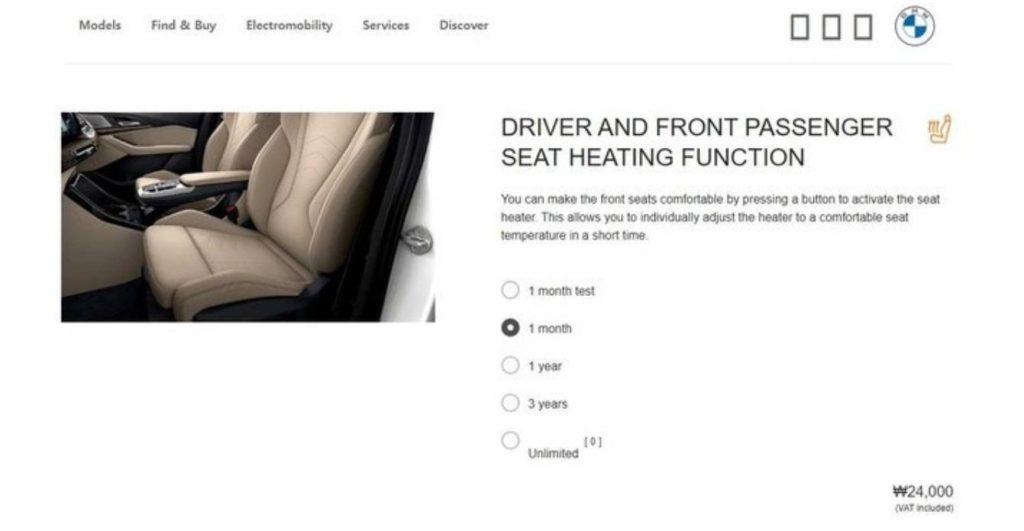BMW Forced to Compromise: When Will Double Charging for Automotive Hardware and Software Finally Disappear?
8 min read
In July 2022, BMW introduced a subscription-based service for hardware-based features such as seat heating and heated steering wheels in its Connected Drive store in South Korea.
The seat heating feature could be used for free for one month, but if users wanted to purchase the entire feature, they would have to pay an additional $406 (approximately 2732 Chinese Yuan); the subscription cost was around $18 (approximately 121 Chinese Yuan) per month, $176 (approximately 1184 Chinese Yuan) annually, or $283 (approximately 1904 Chinese Yuan) for a three-year package.
Having to pay for features in a car you’ve already bought, who could tolerate that? As a result, BMW faced a backlash from a large number of users.
After facing criticism from countless users and what can be described as “internet violence,” BMW has bowed down and announced that it will no longer charge users for hardware-based features like seat heating subscriptions in the future. Instead, the company will focus on subscription models for software and service-related products, such as driving assistance and parking aids.
BMW Forced to Compromise: When Will Double Charging for Automotive Hardware and Software Finally Disappear?
In July 2022, BMW introduced a subscription-based service for hardware-based features such as seat heating and heated steering wheels in its Connected Drive store in South Korea.
The seat heating feature could be used for free for one month, but if users wanted to purchase the entire feature, they would have to pay an additional $406 (approximately 2732 Chinese Yuan); the subscription cost was around $18 (approximately 121 Chinese Yuan) per month, $176 (approximately 1184 Chinese Yuan) annually, or $283 (approximately 1904 Chinese Yuan) for a three-year package.
Having to pay for features in a car you’ve already bought, who could tolerate that? As a result, BMW faced a backlash from a large number of users.
After facing criticism from countless users and what can be described as “internet violence,” BMW has bowed down and announced that it will no longer charge users for hardware-based features like seat heating subscriptions in the future. Instead, the company will focus on subscription models for software and service-related products, such as driving assistance and parking aids.

BMW Forced to Compromise: When Will Double Charging for Automotive Hardware and Software Finally Disappear?
In July 2022, BMW introduced a subscription-based service for hardware-based features such as seat heating and heated steering wheels in its Connected Drive store in South Korea.
The seat heating feature could be used for free for one month, but if users wanted to purchase the entire feature, they would have to pay an additional $406 (approximately 2732 Chinese Yuan); the subscription cost was around $18 (approximately 121 Chinese Yuan) per month, $176 (approximately 1184 Chinese Yuan) annually, or $283 (approximately 1904 Chinese Yuan) for a three-year package.
Having to pay for features in a car you’ve already bought, who could tolerate that? As a result, BMW faced a backlash from a large number of users.
After facing criticism from countless users and what can be described as “internet violence,” BMW has bowed down and announced that it will no longer charge users for hardware-based features like seat heating subscriptions in the future. Instead, the company will focus on subscription models for software and service-related products, such as driving assistance and parking aids.
But the practice of charging for hardware-based services has not entirely disappeared in the realm of luxury automakers, especially among the BBA trio. Some even go beyond seat heating and charge for features like remote smartphone control and customized in-car navigation systems. Additionally, there are subscription fees for hardware-based features like rear-wheel steering, to name a few.
One particular automaker has continued this trend, offering permanent unlocks for front seat ventilation at ¥1999 and seat heating at ¥1299. The brand’s Vice President of Global Sales, Marketing, and After-Sales defended this by explaining that these costs for hardware embedding, production, and installation were not factored into the retail price of the vehicle. Instead, they prefer to call it “flexible optional equipment.”
Alright, so are consumers supposed to owe the manufacturers for this?
Hardware is something you paid for, so why should you have to pay again?
When it comes to brand-imposed charges for hardware-based services, consumers unanimously reject the idea—after all, you’ve paid for the hardware that supports these features, so why should you have to unlock them for an additional fee?
Manufacturers justify this by saying they cater to a relatively affluent demographic, with plenty of personalized add-ons and premium services, all in the name of “humanized customization.” For those who can afford it, these subscription fees may seem like maintenance costs for their vehicles and therefore justifiable. However, many buyers in this bracket might not appreciate the long-term expenses.
It’s important to note that these extra charges are not for an enhanced experience but simply to “unlock” the standard level of experience that the vehicle should already provide. If you’ve paid for the corresponding hardware, there’s no reason you should pay extra.
Smartphones, once purchased, offer access to all their features. In an age where cars are becoming increasingly electronic, why should you have to pay to “unlock” functions?
In addition to consumers protesting this unreasonable charging behavior, some tech-savvy individuals have taken matters into their own hands. Some hackers have declared war on automakers, aiming to crack their paid subscription systems, making these features accessible to all users. Besides hardware unlocks, BMW has also charged users for CarPlay subscriptions, with an annual fee of $80 or a one-time payment of $300.
Opinions on these services are mixed. Some argue that since automakers embed the corresponding hardware in their vehicles, these features should be free. After all, if you’ve paid hundreds of thousands for a car, why should you shoulder an extra “installment fee”? Others believe that subscription services provide flexibility and can reduce overall ownership costs.
If cost savings are the goal, then perhaps automakers should offer hardware features like seat heating and steering wheel heating as optional upgrades. This way, consumers can make informed choices when buying a vehicle, potentially saving money. In simple terms, if manufacturers offer it, they should let consumers use it without additional charges.
I’m genuinely concerned that automakers whose main revenue comes from software services will further squeeze hardware profit margins while increasing software charges. If we don’t “pay to win,” our cars might come with only the most basic driving experience, and everything else will require additional payments. It’s not about what the car can support; it’s about what the manufacturer wants to charge for.

Regarding the issue of automotive charges, different manufacturers have varying viewpoints. Some believe in highlighting their brand’s character through pricing to match consumer levels, while others adhere to the strategy of offering extensive features at the time of purchase with no additional charges later on. Ideal Automobile CEO Li Xiang, who hails from Autohome, has years of experience interacting with consumers, and he understands what consumers want.
In his view, features like autonomous driving or driver assistance are not value-added functions; they are fundamental functionalities that come with a car and should not be charged for. In simpler terms, all hardware-based functions that come with a car should be considered basic capabilities and should not incur extra fees.
Xpeng, for instance, initially announced a paid upgrade for its XPILOT 3.0 intelligent driving assistance system but soon abandoned the fee, opting to include it as standard across all models. Perhaps in Xpeng’s view, a prerequisite for software charges is having a sufficient user base and a high level of user reliance on intelligent driving assistance to make value-added charges feasible.
However, this doesn’t mean that luxury automakers like the BBA trio have a reason to exploit their users or use “personalized services” as a way to widen the wealth gap. Luxury brands relying on optional extras and added costs to create revenue are no longer viable in today’s high-volume market. To generate added value, services must truly stand out and offer something extra or superior.
Perhaps software charges are even more lucrative than hardware?
In fact, most automakers don’t charge for hardware features as standalone items. As profit margins on hardware continue to shrink, car manufacturers are focusing more on software services for additional revenue streams. These services don’t affect a car’s core experience, and users have the choice to enhance their experience. From a presentation perspective, this approach seems more reasonable.
Xiaomi’s foray into the automotive industry revealed that hardware profit margins were no more than 1%. This indicates that relying solely on hardware for profits is a challenging path to follow unless automakers can extract as much profit as possible from hardware by leveraging supply chain control and economies of scale.
Only a few manufacturers can achieve this level of efficiency. The landscape of the electric vehicle market, which is currently marked by intense competition among numerous brands, will inevitably become more consolidated, with leading brands emerging. To survive in this competitive landscape, automakers must first demonstrate greater sincerity in their hardware offerings. They can then concentrate on fee-based services, with the primary aim being to enhance the user experience.
Manufacturers wouldn’t embed hardware into a car without considering any costs upfront, regardless of whether consumers use it or not. The hardware is already installed in the vehicle, and it doesn’t significantly impact costs for the manufacturer if users choose not to activate it. After all, does it cost the manufacturer anything extra for the hardware to be powered on and in use? Therefore, the money users pay is simply to access the experience that the car should inherently provide – it’s a matter of principle.
Charging for software services may actually appear more palatable than enforcing rigid hardware charges. It’s akin to subscription models on video platforms; by subscribing, users gain access to higher video quality and exclusive content, but the core experience remains unaffected for non-subscribers. This is the essence of software charges. Xiaomi, with its expertise in building software ecosystems, may have a more proactive approach in this regard.

So, does this mean traditional automakers have no options? The answer is a resounding “no.” Before having a well-developed ecosystem for software charges, they can continue to enhance their offerings through hardware customization and options. They can also explore opportunities in services like driver assistance and autonomous driving. There are plenty of ways for manufacturers to generate revenue; they just need to be creative.
However, from the consumer’s perspective, like me, aside from essentials like insurance, charging, and parking, we would prefer not to incur any additional costs related to car usage.




